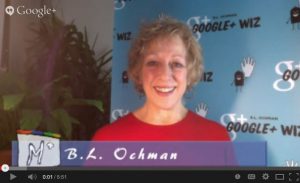Debunking Five Myths About Google+

Are you among the many who say “Oh no! Not another social network! Why should I care about Google+?” You may have heard people saying it’s a ghost town, or that it’s only for techies. The people who write these things are, quite simply, wrong.
The truth is that your association can’t ignore Google+ for another minute. If you’re not putting yourself in the game, you should be. But before you take the plunge, let’s take a look at some of the many myths about Google+.

|
Myth 1: Google+ is a “ghost town.” Mainstream media is particularly fond of this myth.
Fact: 300 million active monthly users is a huge population for a ghost town.
Vic Gundotra, head of social at Google, reported in October 2013 that Google+ experienced a 58% increase in users between May and Oct 2013. The platform has 540 million members, 300 million of whom are monthly active users. Despite what you may have read in the media, that hardly makes Google+ a “ghost town.”
Myth 2: Google+ is a just another social network.
Fact: Google Plus has a strong social component, but it actually is the biggest change in communications since the interactive website. Social interaction is absolutely a part of Google+, but it’s also integrated with Gmail, YouTube (owned by Google), Google Analytics, Google Images, Google Maps, Google Earth, Google Finance, Google Drive, GoogleDocs, Google Wallet and – perhaps most importantly – Google Search.
In other words, Google+ is now the portal to the entire Google ecosystem.
Google’s search algorithm favors content that originates in Google+. Google search looks for relevance, engagement and response.Original content achieves higher search ranking when others engage with the content by sharing it or commenting on it.
That means that a Google+ post that gets a lot of +1s (akin to Facebook “Likes”) and shares will have more weight and better placement in search. Google’s new search algorithm also weighs frequency of posting and whether content is original.
Unlike Facebook, which cut off Google’s access to its data in 2011, and which hides data from Google and Twitter, all Google+ data are immediately and fully accessible to Google search, because Google+ IS Google. Your search ranking will suffer if you don’t use Google+.
Google search crawls Google+ for new, original content. Many web professionals know that Google+ posts show up in Google search almost instantly. Part of the reason is that each Google+ post is assigned its own URL, and is treated like a blog post. The Google+ search feature was added in early October 2011.
Myth 3: Google+ is a niche community just for techies.
Fact: Google+ hosts communities on business topics ranging from management to technology, small to international business, entrepreneurs to large organizations. These communities provide easy access to connecting with influencers and experts who are important to your business.
Google+ allows both public and private communities, making it a great resource for connecting with industry peers, customers and potential customers, vendors and resources.
Privacy and filtering controls allow focused discussion. And Google+ users will attest to the fact that the level of conversation, sharing and willingness to help others in these communities is stellar.
One key feature: Within Google+ communities, your association can use invitation-only or public Hangouts—arguably the best video platform EVER—for teaching, demonstrations, presentations and more to a select, engaged audience.
Myth 4: Google+ is too hard for the average person to use.
Fact: There is a rather steep learning curve in Google+, but that’s because it has so many really useful features—all of which are free. Sadly, Google itself has contributed to this myth because the company simply has not done a good job of explaining its new platform.
At the dawn of the Internet, a lot of people felt that email, websites and e-commerce were too complex to learn. Like the communications tools that came before Google+, those who don’t adapt will soon find themselves left behind in business.
You get out of Google+ what you put in. It takes some time to learn to use the platform effectively. You can save time, money and aggravation by hiring an experienced coach who knows Google+ thoroughly.
Many of the tools Google+ provides are unique to the platform and they are fully integrated into and work seamlessly with other Google products, including Google Apps for businesses.
Among the cool tools on Google+:
- Hangouts on Air – a free web and mobile platform for video conferencing, live events, broadcasts, and live collaboration. Hangouts are arguably (in my opinion) the best video conferencing platform ever, and they are seamlessly integrated with YouTube.
- Shared circles – you can share a circle of contacts you have created, making networking simple and fast.
- Events – a unique sharing solution that makes interaction easy before, during and after the event. These can be public or private and can allow collaborative sharing of documents, presentations, white boards and much more.
- Powerful internal search – it’s easy to find content within Google+. After all, it’s part of Google search.
- Authorship – You’ve probably seen Google search results for articles or blog posts that have small profile photos next to them. Those are the author’s Google+ profile photos.
Google Authorship connects the original content you create (on your own site or someone else’s website) to your Google+ profile and indexes it in Google search.
Having your profile photo attached to your content in Google search results increases click-through rates by as much as 150 percent according to Catalyst.
Myth 5: Google+ communities are no different from Facebook and LinkedIn groups.
Fact: Google+ communities have features not found on any other social platform. Facebook or LinkedIn are stand-alone platforms. Google+ is the evolution of Google, and the gateway to Google search.
With its latest updates, only 2.5 percent of your Facebook followers are likely to see your posts among the cat videos, baby pictures and memes that increasingly clog the content stream.
Now Facebook wants you to pay to promote your posts so more of your fans will see them, in addition to buying advertising.
Unlike LinkedIn Groups (where only human users can join groups), Google+ allows organizations to create and join communities and participate in discussions.
Google+ lets your association create not only public communities, but also ones where the moderator must approve members, in addition to fully private communities.
The beauty of private communities is that these communities, and the posts within them, do not appear in Google search results. This way, private stays private.
Here’s the bottom line: If you don’t use Google+ you will lose out in search rankings compared to sites that do. That fact was confirmed by Google co-founder and former CEO Larry Page who said, “If you ignore Google+, Google Search will ignore you.” No association can afford to let that happen!
Watch this 5-minute video by B.L. to learn how to set up your Google+ profile like a pro:
B.L. Ochman is a digital strategist to blue chip companies, Google+ coach for associations and agencies, publisher of the What’s Next Blog, CEO of MaximumPlus Workshops and a contributor to AdAge Digital Next. She was recently named one of the top 40 social media strategists in the world. She is based in New York City.


